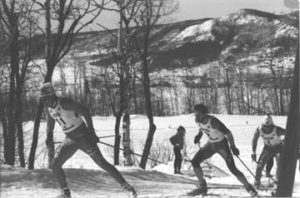How to race your personal best
We interrupt for an online discussion on this topic…
Jason Carter wrote:
>
> JP wrote:
>
> >Here’s a lousy reference: a guy who posts here has an article at the
> main XC site in the Training section about pacing and race strategy.
> It was really good.
>
> What guy or where is the “main XC site”? I’m not sure what you’re meaning
> here. Are you being derogatory or saying that you can’t remember the site
> and the name of an author?
Only that I didn’t remember anything or have a good URL to provide like a
decent netizen, but Gene covered my butt.
> On the pulsing distinction, my understanding is that any time there is an
> attack in a race, intensity increases to the similar levels to going up a
> hill in skiing.
Right. But whose intensity? If you attack, it’s fine if your intensity goes
high but the article says you have to still stay “in control.” If someone
else attacks and you can’t stay in control (of all your systems), then
you should not follow. Also, this is for the Start and Middle parts of the
race. The Finish portion is open-ended for effort. It’s always a step up
from the Middle part. *IF* you want to ski your fastest possible event.
—The article is about skiing an event fastest. Al Hershlag (spelling?)
says that all tactics result in a slower event than max possible. They are
a strategic modification resulting in slower overall time—and of course
they are only useful if they achieve their goal. A superhard attack to drop
some particular person will result in slower skiing over the rest of the
course, but that person may be effectively dropped anyway.
> If the athlete blows it and goes up to level 5 in the attack or on the hill,
> in other words less than 2 minute max effort sprint and well beyond the AT
> threshold, he is forced into recovery mode for the rest of the race, or at
> least limited to level 4 efforts or under the AT threshold for remaining
It is possible that someone can attack like this and still stay “in control”
and recover on a downhill and simply use such efforts as part of their
fastest possible race. Everyone’s level of ‘too hard’ is different. But I suppose
there is a technical limit. Some can come back from ‘eyes crossed’ many times
in an event. I thought it very interesting that Al used the term ‘in control’
as the gauge for effort for Middle of the race.
> time. In skiing with more hills, the terrain necessitates max efforts and
> mere mortals can’t get away from it, especially if technique and base
> training is inadequate. This is why the Birkie can hurt so much. In other
> type of racing, the competition creates the max efforts and mere mortals are
> dropped, but they can still finish the flat course with a little bit left.
For your fastest event, Al says that the Finish portion needs to be faster
than the Middle. You should then have ZERO left. : )
It was a very neat article. I liked his Start portion pacing of no faster
than average of previous race. I also liked his idea that the length of all
the parts was variable. (Best skiers might have shorter Start portions
and longer Finishes!)


